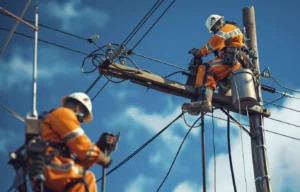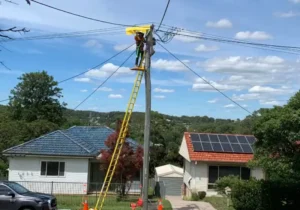Many homes in Australia have private steel poles at the front of their property, which is used to support electrical cables and other utility services. While these poles are designed to last for decades, they are susceptible to rust and corrosion, especially in coastal areas with salty air. That’s why it’s essential for homeowners to regularly check their private steel poles for signs of rust and corrosion. In this blog, we’ll discuss why checking for rust is critical and what the outcome could be if homeowners don’t.
Why is Checking for Rust Important?
Rust and corrosion can weaken the structural integrity of steel poles, making them more susceptible to damage from wind, rain, and other weather conditions. Over time, rust can eat away at the metal, causing holes and weakening the pole’s ability to support utility services. Additionally, rust can cause electrical grounding issues, increasing the risk of electrical shocks and fires.
What Can Happen If Homeowners Don’t Check for Rust?
If homeowners don’t check their private steel poles for rust and corrosion, it can lead to several potential issues, including:
Pole Failure: Over time, rust can weaken the steel pole to the point where it can no longer support utility services. This can cause the pole to bend or collapse, resulting in power outages, property damage, and even injury.
Electrical Grounding Issues: Rust can cause electrical grounding issues, increasing the risk of electrical shocks and fires. If the pole is not grounded correctly, it can damage electrical equipment and appliances.
Non-compliance with Regulations: Homeowners may be liable for fines or legal action if their private steel poles do not comply with current safety regulations.
How Often Should Homeowners Check Their Private Steel Poles for Rust?
Homeowners should check their private steel poles for rust and corrosion at least once a year, especially in coastal areas or areas with high humidity. Additionally, if there is visible damage to the pole, such as bending or cracking, it’s essential to have it inspected by a licensed electrician or utility service provider.
Sometimes the electricity distributor can check your private pole, and if it is not up to standards or unsafe, they will issue the homeowner with a defect notice.
The reasons for receiving a defect notice for a rusty private electricity pole can vary. Still, most commonly, it is due to the pole’s structural integrity being compromised due to rust or corrosion. Over time, exposure to the elements and natural wear and tear can cause steel poles to rust and weaken, making them a safety hazard to the public.
If you receive a defect notice for a rusty private electricity pole, there are several steps that you should take to ensure compliance with safety regulations:
- Contact a licensed Level 2 ASP: The first step in addressing a defect notice is to contact a licensed level 2 ASP electrician who can assess the extent of the damage and provide recommendations for repair or replacement.
- Obtain a quote: After assessing the damage, the electrician can provide you with a quote for the cost of repairs or replacement.
- Schedule repairs: Once you have obtained a quote, you can schedule repairs or replacement of the private electricity pole within the timeframe specified in the defect notice.
- Notify the network distributor: Once repairs or replacements have been completed, you must notify the network distributor and provide proof of compliance.
Failure to comply with a defect notice can result in legal action and potential liability for any damages or injuries caused by the faulty pole. Additionally, repairing or replacing a private electricity pole can be costly, depending on the extent of the damage and the complexity of the installation.
To avoid receiving a defect notice for a rusty private electricity pole, homeowners should regularly check their private poles for rust and corrosion and take proactive steps to maintain their structural integrity. By working with licensed professionals and complying with safety regulations, homeowners can ensure the public’s safety and avoid potential liability, cost, and disruption associated with a defect notice.
In conclusion, checking your private steel poles for rust and corrosion is essential for maintaining the structural integrity of the pole and reducing the risk of electrical hazards. By taking proactive steps to ensure that your private steel poles are in good condition, you can ensure your property’s and its occupants’ safety and avoid potential liability issues. Receiving a defect notice for a rusty private electricity pole at the front of your property from Ausgrid can be a serious matter. A defect notice is a formal notification that the private electricity pole does not comply with safety regulations and must be repaired or replaced within a specified timeframe.
Many homes in Australia have private steel poles at the front of their property, which is used to support electrical cables and other utility services. While these poles are designed to last for decades, they are susceptible to rust and corrosion, especially in coastal areas with salty air. That’s why it’s essential for homeowners to regularly check their private steel poles for signs of rust and corrosion. In this blog, we’ll discuss why checking for rust is critical and what the outcome could be if homeowners don’t.



